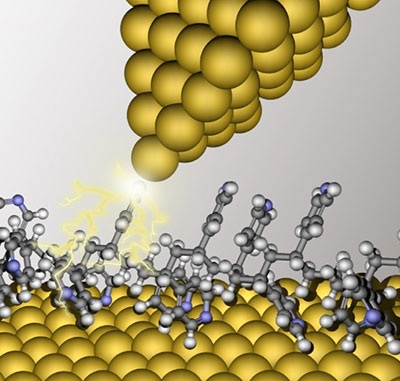May 29 2019
Researchers at Tokyo Institute of Technology and University of Tsukuba show that polymers have a crucial role to play in the fabrication of single-molecule electronic devices, enabling researches to expand the boundaries of the nanoelectronics revolution.
 Single-molecule junctions composed of the STM tip and a polymer. (Image credit: Tokyo Institute of Technology)
Single-molecule junctions composed of the STM tip and a polymer. (Image credit: Tokyo Institute of Technology)
One of the most prominent aspects of current electronic devices is their size and the size of their components. Pushing the boundaries of how small an electronic component can be created is one of the core topics of research in the field of electronics globally, and for good motives. For example, the correct manipulation of extremely small currents using nanoelectronics could enable researchers to not only expand the current boundaries of electronics, but also bestow them new functionalities.
A research team guided by Tomoaki Nishino, Associate Professor of the School of Science at Tokyo Institute of Technology (Tokyo Tech) is investigating the depths of miniaturization; basically, they are working on single-molecule devices. "Ultimate miniaturization is expected to be realized by molecular electronics, where a single molecule is utilized as a functional element," explains Nishino.
However, as one would imagine, developing electronic components from a solitary molecule is not an easy task. Functional devices having a single molecule are tough to fabricate. Moreover, the junctions (points of "electric contact") that involve them have limited lifetimes which makes their application problematic. Based on earlier works, the researchers inferred that a long string of monomers (single molecules) to develop polymers would produce better results than smaller molecules. To prove this idea, they used a method called scanning tunneling microscopy (STM), wherein a metallic tip that ends in a single atom is used to measure very small currents and their fluctuations that happen when the tip forms a junction with an atom or atoms at the target surface. Through STM, the scientists developed junctions made up of the tip and either a polymer known as poly(vinylpyridine) or its monomer counterpart, known as 4,4'-trimethylenedipyridine, which can be viewed as one of components of the polymer. By measuring the conductive properties of these junctions, the scientists aimed to establish that polymers could be beneficial for fabricating single-molecule devices.
However, to perform their analyses, the researchers first had to formulate an algorithm that permitted them to extract quantities that were of importance to them from the current signals measured by the STM. In brief, their algorithm permitted them to automatically identify and count small plateaus in the existing signal measured over time from the tip and the target surface; the plateaus specified that a steady conducting junction was formed between the tip and a single molecule on the surface.
Using this method, the research team examined the results attained for the junctions formed with the polymer and its monomer equivalent. They discovered that the polymer produced much better properties as an electronic part than the monomer. "Probability of junction formation, one of the most important properties for future practical applications, was much higher for the polymer junction," states Nishino. Furthermore, the lifespan of these junctions was found to be greater, and the current flowing through the polymer junctions was more steady and predictable (with minimal deviation) than that for the monomeric junctions.
The results demonstrated by the researchers expose the prospect of polymers as building blocks for electronics miniaturization in the days to come. Are they paramount for pushing the limits of the realizable physical limits? Hopefully, the future will reveal that.